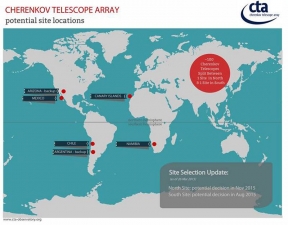Another milestone in the Cherenkov Telescope Array project
31-03-2015
CTA Resource Bard composed of representatives of various government agencies financing the Cherenkov Telescope Array (CTA) global project met on March 26 in Heidelberg. Selection of a site for CTA observatory on the northern hemisphere was discussed. 5 discussed locations involved 2 sites in US, 1 in Mexico, and 2 in Canary Islands (Spain). Voting representatives of Austria, Brazil, Czech Republic, France, Spain, Japan, Germany, Poland, South Africa, Switzerland, UK, and Italy have decided to start negotiations with two countries: Spain (La Palma) and Mexico (San Pedro Martir). Two sites in Arizona have been qualified as spare locations. Final decision is expected once the negotiations are concluded in November 2015. More advanced negotiations concerning selection of a site for the southern hemisphere should be concluded in August 2015.
„I’m very satisfied that two excellent sites for northern hemisphere CTA observatory have been selected. We are going to start negotiations to select the best site just in coming weeks” – said Resource Board Chairperson, Dr Beatrix Vierkorn-Rudolph. Professor Werner Hofmann, CTA project Leader added: „I expect that the final decision will be made before the end of this year. Researchers all over the world are eagerly looking forward for opportunities created by CTA”.
Currently the CTA project is in the so-called “pre-production phase”, the last phase preceding commencement of development of research apparatus for the observatory. Selection of sites for both hemisphere observatories is a key decision on the way towards project accomplishment. Dr Christopher Townsley, Technical Manager of the project said: „Knowing already the sites we are now eagerly waiting for final decisions concerning technical solutions to be used to construct arrays of telescopes. Construction of the first telescopes is to commence at the beginning 2016, as soon as the observatory sites are finally approved.”
Potential sites for CTA observatory were selected and qualified by SITE, an international task force composed of scientists from Europe, both Americas, and Africa. Professor Tomasz Bulik from Warsaw University has been managing the SITE project. Automatic data-logging stations deployed in ten selected sites on both hemispheres, in-depth analyses of satellite-gathered data for the sites, and computer models of weather conditions at the sites are among the most important outcomes of the project. „I am deeply satisfied that the final decision on selection of sites for CTA observatories is so close ahead. For me and for my colleagues from the SITE task force the decision will be a culmination of several years of hard work.” – said Professor Bulik.
CTA will be the largest and the most sensitive observatory of gamma radiation of very high energies. More than 1000 researchers from 170 research institutions in 29 countries (including a large consortium of 9 research institutions from Poland) are involved in the project. CTA will be opened for all Polish researchers interested in extraterrestrial high-energy phenomena including natural accelerators of particles in the Universe. CTA will be ten times more sensitive than the so-far used equipment. Therefore scientists hope that it will be capable to investigate some yet unexplored extreme cosmic objects and unique physical phenomena/processed running there.
CTA will consists of more than 100 telescopes deployed in two sites, one on the northern hemisphere, and one on the southern hemisphere (the latter will be somewhat smaller). Evaluation of potential sites for CTA observatories involved in-depth characterisation of weather conditions, simulations of sensitivity of the planned apparatuses, as well as detailed construction and operation cost-estimates.
NCBJ has just joined the CTA consortium works.





